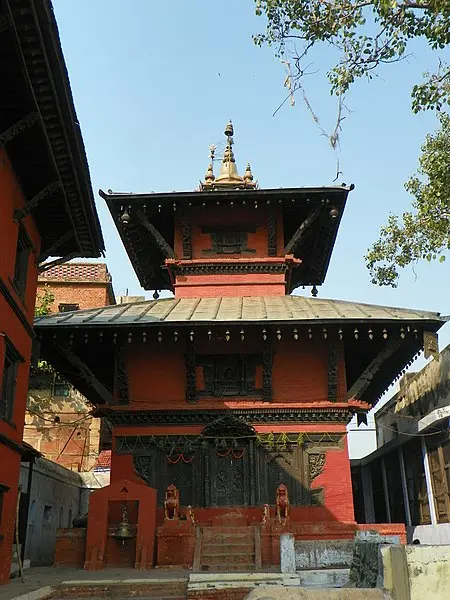Varanasi is known as the eternal city and is one of India’s holiest places. The Pashupatinath Temple is a key symbol of spirituality and cultural heritage here.
The Pashupatinath Temple Varanasi, also known as Shri Samrajeswar Pashupatinath Mahadev Mandir and Nepali Mandir, is a significant religious site. It shows the cultural and spiritual ties between India and Nepal. This temple, built in the 19th century, is a replica of the famous Pashupatinath Temple in Kathmandu, Nepal.
Pashupatinath Temple Varanasi draws thousands of pilgrims and tourists each year. They come for its rich history and architectural beauty. In this article, we explore the temple’s details, its history, and its spiritual essence.

The History of Pashupatinath Temple Varanasi
Pashupatinath Temple Varanasi‘s history starts in the early 1800s. Rana Bahadur Shah, the King of Nepal, was exiled in Varanasi from 1800 to 1804.
During his exile, he adopted the moniker Swami Nirgunanda. He was devoted to Lord Shiva and wanted to create a spiritual sanctuary like his homeland. So, he built a temple that mirrored the original Pashupatinath Temple in Kathmandu.
Construction started during his exile. He used materials like terracotta, stone, and wood from Nepal. The temple’s style is distinctly Nepali pagoda, with intricate carvings and a unique wooden structure.
The temple’s design features detailed sculptures. This has earned it the nickname, Mini Khajuraho, due to its carvings’ resemblance to those at the famous Khajuraho temples in India.
Rana Bahadur Shah’s life was cut short when he was assassinated by his stepbrother on April 25, 1806. The construction of the temple was left incomplete at that time.
It wasn’t until 1843 that his son, Girvan Yuddha Bikram Shah Deva, finished the project. Two decades after its initial deadline. The land was formally given to Rana Bahadur Shah by Kashi Naresh in 1843. The Nepal government manages the temple to this day.
Architectural Features of Pashupatinath Temple Varanasi
The Pashupatinath Temple Varanasi is known for its exquisite craftsmanship and architectural beauty.
Materials: The temple is made from terracotta, stone, and wood. The use of termite-resistant wood helps preserve its structure over time.
Design: Its pagoda-style architecture has a beautifully gilded roof and elaborate carvings. These carvings depict various deities and motifs important to Hindu mythology.
Artistic Details: The intricate wood carvings are a highlight of the temple. They show the devotion and skill of the artisans. Unfortunately, much of the original wood structure has deteriorated. This has led to some areas being rebuilt with brick while preserving valuable damaged wood carvings for display.
The temple complex also includes a dharamshala (guest house) and the Siddhagiri Mutt, known as Rajrajeshwari Temple.
Cultural Significance
The Pashupatinath Temple Varanasi is deeply religious for Hindus worldwide. It is dedicated to Lord Shiva, worshipped here as Pashupati, meaning “Lord of Animals.” This temple is a key pilgrimage site for devotees from both India and Nepal. It fosters unity between the two nations.
The temple’s location on Lalita Ghat, near the Ganges River, adds to its spiritual ambiance. Pilgrims often visit after performing rituals at other nearby ghats. It’s a crucial part of their spiritual journey in Varanasi.
Modern-Day Relevance
In recent years, the Pashupatinath Temple Varanasi has seen more visitors. This is thanks to the Kashi Vishwanath Corridor. The corridor makes it easier to get to the temple and other religious sites in Varanasi.
This has made the temple a symbol of unity between India and Nepal.
Today, the Pashupatinath Temple Varanasi draws visitors for many reasons. They come for its spiritual value, architectural beauty, and historical importance. It reminds us of the shared cultural heritage and mutual respect between India and Nepal.

Visiting the Pashupatinath Temple Varanasi
The Pashupatinath Temple Varanasi, also known as Shri Samrajeswar Pashupatinath Mahadev Mandir, is a key pilgrimage site. It attracts thousands each year. Here’s a guide to help you plan your visit.
Pashupatinath Temple Varanasi location
The temple is at Lalita Ghat, near the Ganges River in Varanasi, Uttar Pradesh. It’s about 4 kilometers from Varanasi Junction railway station. You can get there by
Pashupatinath Temple Varanasi timings
The temple is open every day from 4:30 am–11 pm.
How to Reach Pashupatinath Temple Varanasi
The temple is easy to reach because of its central location in Varanasi. It’s connected by road, rail, and air.
By Air: The nearest airport is Lal Bahadur Shastri International Airport, about 25 km away.
By Rail: Varanasi Junction, 4 km from the temple, is the main railway station.
By Road: Auto-rickshaws and taxis offer convenient ways to get to the temple.
Travel through Kashi Vishwanath corridor
The Kashi Vishwanath Corridor, opened in December 2021, has improved Varanasi’s tourism. It makes it easier to visit the Pashupatinath Temple and other sites. This corridor shows India-Nepal unity and attracts many visitors.
It has reduced overcrowding, allowing for a better experience. Visitors can now easily move between sacred sites.
The Pashupatinath Temple is a place of worship and a cultural landmark. It shows the shared heritage of India and Nepal. Many visiting the Kashi Vishwanath Temple also go here for its spiritual and historical value.
Visiting the Pashupatinath Temple is a must when exploring the Kashi Vishwanath Corridor. It adds depth to your experience of Varanasi’s spiritual landscape.
Final Thoughts
The Pashupatinath Temple Varanasi is more than just a marvel. It represents the spiritual bond between India and Nepal. Its history and cultural importance make it a key destination in Varanasi.
Whether you seek spiritual enlightenment or just want to see its beauty, this temple offers a deep experience. It touches the hearts of visitors from all backgrounds.
As tourism grows in Varanasi, the Pashupatinath Temple remains a symbol of faith and unity. It connects two nations with shared traditions and beliefs.
2 thoughts on “Pashupatinath Temple Varanasi: A Sacred Replica”